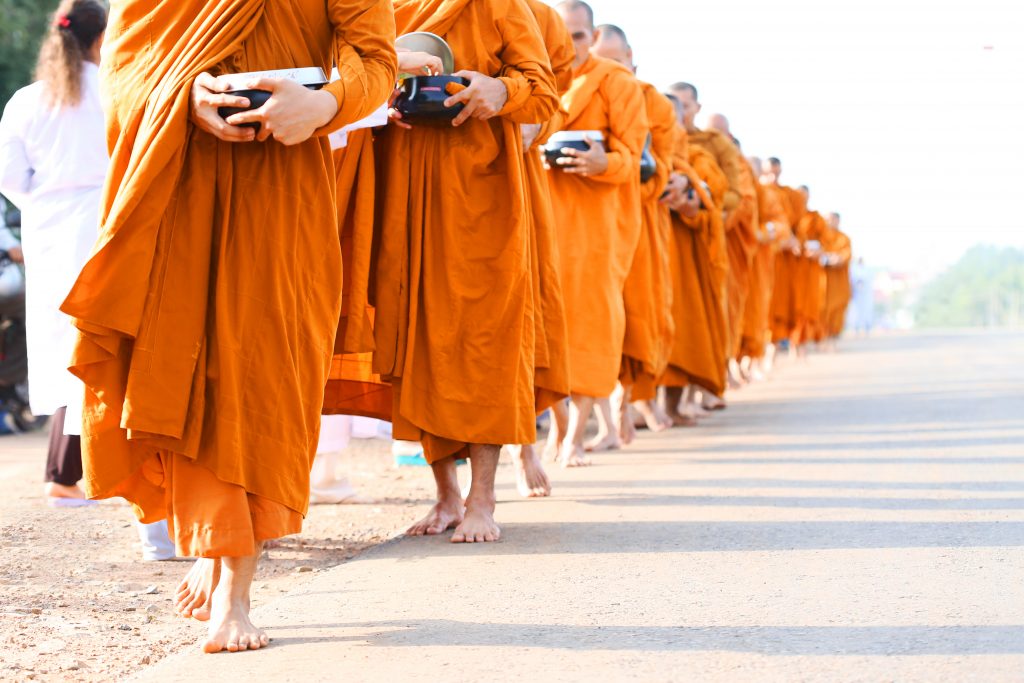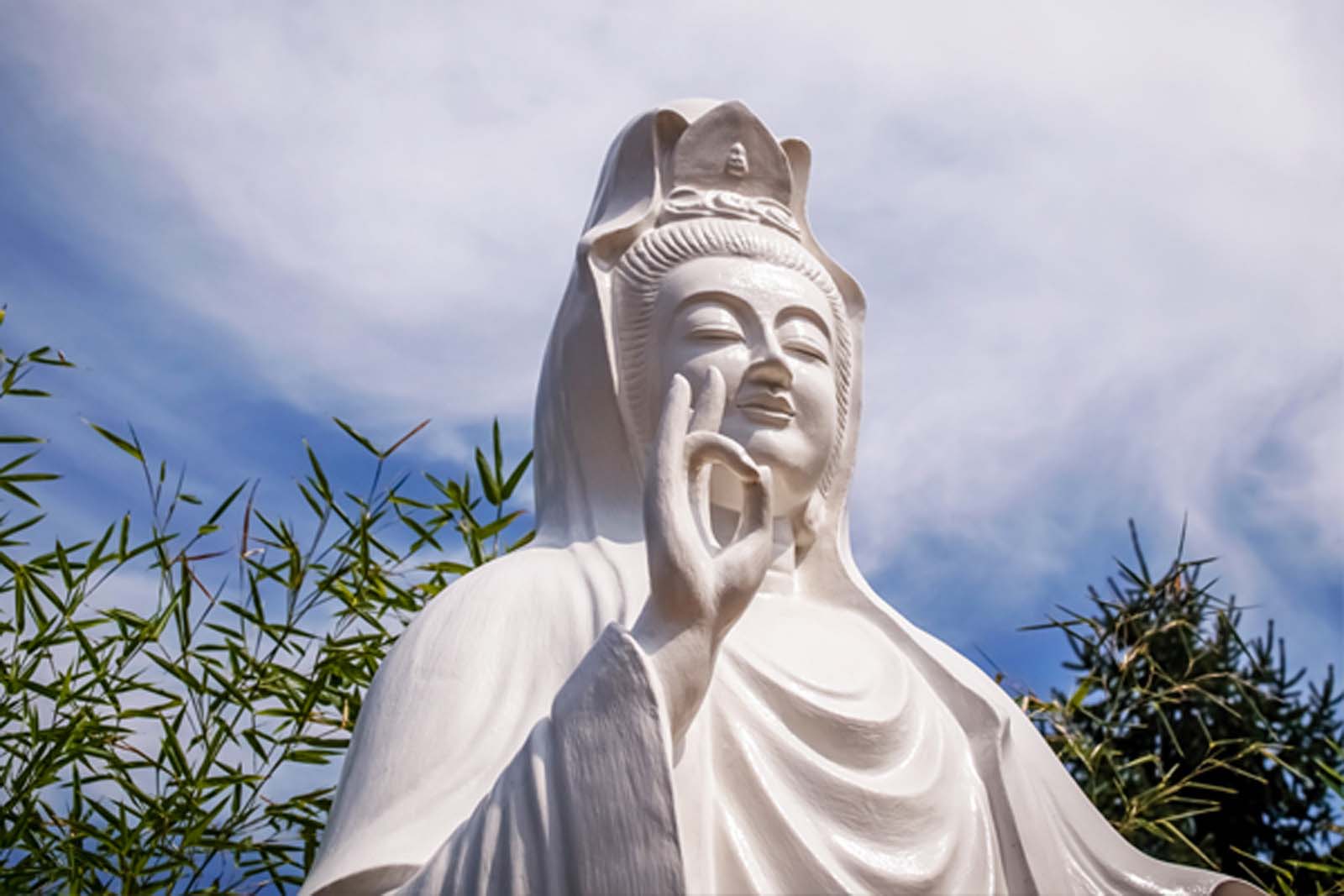The Path to Freedom & the light that dispels darkness
ALL TEACHINGS OF THE BUDDHA POINT US TOWARDS LIBERATION
More than 2,600 years ago, the prince of the Sakyan clan, Siddhārtha Gautama left home in search for answers to the causes of sufferings and the escape. Awoken to the true nature of life, he became known as the Buddha, the Enlightened One. Subsequently, the Buddha out of compassion guided countless sentient beings towards the most expansive happiness possible.
- The Four Noble Truths
- The Threefold Practice
- The Different Buddhist Traditions
- The meaning behind rituals
His essential and core teaching is The Four Noble Truths.

1. Life is Challenging
Life is inherently fraught with challenges, which are not always evident. When we become aware that the nature of day-to-day existence is suffering, we don’t have to be miserable with the thought that suffering is always present.
2. The cause of suffering
The cause of our suffering is our attachment to our desires of our possessions and the way things should or should not be.


3. A non-struggling, peaceful mind is a possibility
With right understanding of life’s true nature and complete acceptance, mind is peaceful. This can’t be done with an act of will. Instead, it is a journey of changing our habits to see and understand the true nature of reality.
4. The process for ending suffering is the Noble Eightfold Path

A consistent awakening through developing the following eight:
- Wise Understanding: knowing the causes & cessation of suffering;
- Wise Intention: motivation to end suffering;
- Wise Speech: speaking in a way that cultivates clarity and peace;
- Wise Action: behaving in ways that maintain clarity and peace;
- Wise Livelihood: supporting oneself in a wholesome way;
- Wise Effort: cultivating skillful (peaceful) mind habits;
- Wise Mindfulness: cultivating alert, balanced attention;
- Wise Concentration: cultivating a steady, focused ease-filled mind.
The Three-Fold Practice
Wisdom:
Wisdom enables us to see reality as it is and not how we would like it to be. It allows us to take time to form opinions and beliefs rather than quickly jumping to conclusions and reacting to our emotions. It provides a window of pause for us to change our mind when facts presented to us contradict our beliefs.
“Wisdom is the understanding where happiness can be found”- Ajahn Brahmali
Wisdom is purified by virtue and virtue is purified by wisdom. The wise try to help when they can, never forgetting that there is no guarantee their efforts will be successful.
As a result, they do not indulge in disappointment when things do not work out. If their efforts to help others are disrupted, they dwell in calmness. They are ready to try again whenever the conditions allow.
Virtue:
The five precepts are the basis of Buddhist virtue for lay practitioners but are not all of it. We start by recognising how our negative behaviour causes us unhappiness. Through understanding, we learn to act skilfully by developing virtues. When we see how skilful actions lead to happiness, we start doing good. For example, the second precept (refraining from taking what is not given) is first upheld before one proceeds to build their skill of generosity and sharing.
“To Avoid evil, Do Good, Purify the Mind”
The Five Precepts:
- To refrain from killing living beings
- To refrain from stealing/taking what is not given
- To refrain from sexual misconduct
- To refrain from false speech
- To refrain from the consumption of alcohol and intoxicating drugs that lead to heedlessness
The unique feature of Buddhist virtue is that rather than being perceived as a matter of obedience to a list of conducts given by a higher power, virtue is seen as a form of training one’s conduct. Only when precepts are understood and taken voluntarily, they provide a strong basis for more advanced training of the mind taught by the Buddha.
The Buddha taught that voluntarily refraining from harmful actions and speech has a major part to play in creating a society of mutual trust and respect.
Meditation (Samādhi):

Meditation (Samādhi in Pali) is one of the methods used to modify the habitual tendencies of the mind, as does speaking or refraining from acting in certain ways. The training of meditation helps us to un-condition negative habitual tendencies such as obsessive worrying and replace them with positive habitual tendencies such as acceptance & letting go.
“Meditation is a way of cultivating the mind. Cultivating it toward what end? Cultivating it to the point that whatever occurs, the mind no longer gives rise to mental impurities.”
– Ajahn Buddhadasa
Samadhi is a quality of the mind of non-distraction. The Noble Eightfold path provides the path to developing virtue and mindfulness leading to deep concentration. With one applying right effort, one abandons unwholesome mental states and gives rise to wholesome mental states, enabling one to sustain a calm mind that is free from discursive thoughts.
The Different Buddhist Traditions
As Buddhism spread out of India to all corners of the world, many different schools with their own beliefs and practices emerged. Despite these differences, these traditions share a conviction that one can come to understand the meaning of existence by living a skilful life dedicated to spiritual cultivation.

Theravada – The Way of the Elder
This tradition is the representation of early Buddhism. Their doctrine emphasizes self-development and the gradual cultivation towards liberation. The teachings lean towards the lives and teachings of the Buddha and his immediate disciples. These teachings are preserved in the ancient Pali language and stored in a vast canonical compilation called the Tipitaka.
Goal of the practice:
The attainment of liberation, freedom from the cycle of rebirth & suffering. One who has successfully extinguish his defilements is known as an Arahant.
Predominant regions:
Thailand, Myanmar, Sri Lanka, and SEA

Mahayana – The Great Vehicle
This tradition emphasises on aiding the liberation of a large number of sentient beings from the round of rebirth & suffering (Samsara). More prominent sub-schools of Mahayana are the meditative ‘zen’ and the devotional ‘Amitabha’ school. The teachings emerged about 2,000 years ago which was more accommodative to new ideas and regional differences in the Buddhist interpretation.
Goal of the practice:
The attainment of liberation is not just for oneself but for all sentient beings. This school espouses the Bodhisattva ideal – to be a great being who encompasses virtue, compassion & wisdom and vows to be reborn again and again for the sake of alleviating other being’s sufferings.
Predominant regions:
China, Vietnam, Korea, Japan

Vajrayana – The Diamond Vehicle
Diamond, being one of the toughest material in the world, is used to represent the ability of the Dhamma to cut through all defilements and mental afflictions. Vajrayana first entered Tibet at the invitation of Tibetian King Songstän Gampo in early 7th Century CE India. This sect focuses on the use of elaborated rituals, known as Tantras, and personal root teachers to remove obstacles to the realization of the Dhamma.
Similar to Mahayana, this sect espouses the Bodhisattva view and the belief in the general Mahayana Pantheon of Buddhas, Bodhisattvas and deities. There is also a belief in tulku – a teacher that reincarnates and continues the dispensation of Dhamma life after life.
Predominant regions:
Nepal, Bhutan, Tibet
With different traditions and different emphasis on the Buddha’s teachings, there are common threads that spread across the traditions. This includes a unified faith in the three jewels – the Buddha, the Dhamma, and the Sangha. What differs between the schools is the means to the same goal of enlightenment.
With peace & harmony as a key feature of Buddhism, Buddhist sects have never gone to war over their ideals and have flourished alongside in peaceful coexistence.
The meaning behind Buddhist rituals
Chants
In the early years of Buddhism, the teachings of the Buddha were preserved through oral transmission. Chanting is one way for us to connect back with the countless generations of practitioners. The chants include verses that list the qualities of the Buddha, the Dhamma and the Sangha. Included are key teachings of the Buddha for wise reflection, as well as verses to remind us to be friendly to ourselves and all those we come into contact with, and sharing our merits with departed relatives.
These verses are recited in the Pali language. Pali is a language used in Theravada Buddhist scriptures. As the scriptures contain the teachings of the Buddha, chanting helps reflect and recollect his words of wisdom. This can aid one in internalising the meaning of the teachings and in realising the truth.
Chanting helps us develop gratitude towards those who have passed down the teachings. It also helps to calm the mind after a long day, and reminds us to develop positive mental qualities that we can work towards.
Offerings
Offerings are made to the Buddha not because the Buddha needs them or for us to win divine favours. Offerings are made to create positive mental states of generosity and gratitude.
Flowers:

Flowers are one of the most beautiful manifestations of nature, which we often use to beautify our surroundings. We tend to cling to beautiful things. By offering flowers, it reminds us that when they fade, our world also fades. All that we hold onto are impermanent.
Candles:

Light dispels darkness and lighting candles reminds us of the Buddha’s wisdom, which is like light that dispels the darkness of our ignorance. It reminds us to keep the wisdom of the Buddha within our hearts and minds.
Fruits:

Fruits remind us that when we put in skilful effort to our practice, these efforts will bear fruit eventually. We are heirs to our actions and are born of our actions.

Incense:
Fragrance emitted from incense reminds us of the fragrance of the Buddha’s teachings that is able to spread far and wide. It reminds us of the fragrance of pure moral conduct that brings happiness when we understand how to act skilfully. The fragrance of our practice brings peace and calm to the mind.
Water:

Water symbolises purity and clarity of the mind. We are reminded that our actions, speech and thoughts have an impact on our mind. Hence, the offering of water reminds us to be skilful and avoid the taints of the world.
The best offering?

The best offering we can render is the offering of our own practice to the Buddha. To walk and practice the path as laid out by the Buddha enables us to lead a happier and peaceful life. This approach to life not only benefits ourselves but also others.
Statues
In Buddhism, the statue of the Buddha reminds us of the human dimension in Buddhist teachings. Practitioners pay respect by prostrating to the Buddha statue in the same manner we would show respect to someone or something we admire. This gesture of respect reduces our ego and opens up our mind to learning.
Having a Buddha image reminds us of the qualities of the Buddha and serves to inspire us to develop the qualities within ourselves.

